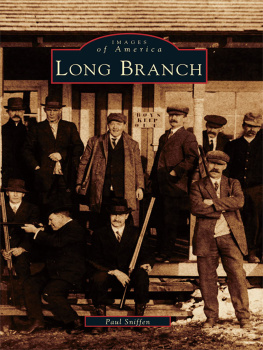Published by The History Press
Charleston, SC 29403
www.historypress.net
Copyright 2007 by Sharon Hazard
All rights reserved
Cover image: Band concerts were held at Ocean Park every afternoon in the summer.
First published 2007
e-book edition 2013
ISBN 978.1.62584.476.7
Library of Congress Cataloging-in-Publication Data
Hazard, Sharon.
The golden age in Long Branch : tales of fascinating and famous people / Sharon Hazard.
p. cm.
Includes bibliographical references.
print edition ISBN 978-1-59629-216-1 (alk. paper)
1. Long Branch (N.J.)--Biography--Anecdotes. 2. Celebrities--New Jersey--Long Branch--Biography--Anecdotes. 3. Long Branch (N.J.)--History--Anecdotes. 4. Long Branch (N.J.)--Social life and customs--Anecdotes. I. Title.
F144.L8H39 2007
974.946--dc22
2007006590
Notice: The information in this book is true and complete to the best of our knowledge. It is offered without guarantee on the part of the author or The History Press. The author and The History Press disclaim all liability in connection with the use of this book.
All rights reserved. No part of this book may be reproduced or transmitted in any form whatsoever without prior written permission from the publisher except in the case of brief quotations embodied in critical articles and reviews.
Long Branch, New Jersey, is a town stretching along a sturdy bluff that rises above the Atlantic Ocean. According to the November 19, 1926 issue of the Long Branch Daily Record, the town got its name from its location on the longest branch of the Shrewsbury River, which forms its northwest border. In 1876 Harpers Magazine described it as looking remarkably long and narrow, like a ladys foot. It is five miles long and a mere four miles wide. Because of its location along a twenty-foot-high bluff, Long Branch is often referred to as the American Brighton, after the popular resort of Brighton in England that has a similar topography. Even some of the streets and areas of the town are named after Englands Brighton area. The easternmost section of Long Branch is called the West End after its English counterpart. The streets surrounding this area are named West End, Brighton, Chelsea and Bath after places in England.
However it is physically described, Long Branch is a place where the sea and the shore have met, sometimes peacefully and many times dramatically, long before any humans had the pleasure of leaving their footprints in the sand.
Besides this ceaseless coming together of sand and surf, through the years there have been many other meetings along this coastline. These were the interactions of people who were drawn to the sea for many reasons: some came for rest and relaxation, some for the health benefits of the sea air and others visited for business or just plain pleasure. Many of these people were rich and famous, powerful and politically connected. In addition to the noted visitors, many others were born, worked, lived, died and were buried in Long Branch. What they all had in common was an appreciation of this unique place with its unparalleled view of the ever-changing Atlantic Ocean, and the fond memories they had of their time spent here.
Many of the people who walked along the speckled sands of the citys shoreline are long forgotten. Some of them were famous in their time and their names are readily recognized. Others were popular in the era when they lived, but their names have been forgotten. Most people today dont know how important these celebrities were to Long Branch in its golden years. So many famous people visited during the mid-nineteenth and the early twentieth centuries that the New York Times ran a daily column on the front page called In the Summertime. It listed the comings and goings of the people visiting Long Branch, where they were staying, how many horses they brought with them, what kind of carriages they were driving and with whom they were socializing. Harpers Weekly and Frank Leslies Illustrated Newspaper had reporters and artists camped out in Long Branch to cover the doings of each summer day.
Promenade on the Long Branch boardwalk. Pat Curley Schneider.
The Long Branch boardwalk, a hallmark of the Jersey Shore. Authors collection.
The following chapters will share the stories of these people by bringing back to life Long Branch in its golden years. These pages will paint a picture of what the town looked like when vacationers strolled along the shore, danced in the hotel ballrooms, gambled large sums of money in the casinos, built magnificent mansions and socialized with the powerful people and political pundits of the time.

Before there was enough activity in the town to warrant a complete front-page column in a national newspaper or an illustration in a weekly magazine, Long Branch had its share of visitors. In 1814, when the town had a total of only fourteen boardinghouses and hotels, a young girl was visiting: Victorine DuPont of Wilmington, Delaware. It seems she was seeking the health benefits and social activity of this town that meandered peacefully along the bluff. The letters she wrote home to her sister during the month of August gave a vivid description of the sights and sounds of her two-week stay in Bennets Hotel in Long Branch. It was located on a corner, on the east side of the present-day Ocean and Bath Avenues. Her initial impression on her first day in residence at the hotel describes a barren land with no trees, just an expanse of brown earth rolling freely to the ocean. Apparently she came to Long Branch to get over some sort of melancholy or sadness. In a letter she wrote, This landscape does not do much for lifting spirits. Is this the spot where the young, the gay, and the fashionable visit for amusement and to enjoy the country in the summer? However, as her first week unfolded she began to appreciate her presence in a place so close to the sea. She wrote home that the sea presented a most beautiful sight:
I am very well pleased with it because it is something new. I love to cast my eyes on that vast expanse of water where many sails are to be seen, and also little boats which look like small specks upon the sea. All this is calculated to awaken great thoughts and to make one reflect, but I think also to improve melancholy. The noise of the waves which I hear constantly breaking upon the shore is soothing. I cannot think of a situation more calculated to improve melancholy than one on the sea coast, as you are constantly exposed to witness something which you cannot believe


















